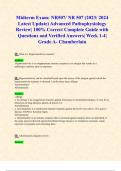Midterm Exam: NR507/ NR 507 ( 2023/ 2024 Lates t Update) Advanced Pathophysiology Review| 100% Correct Complete Guide with Questions a nd Verif ied Answers | Week 1-4| Grade A - Chamberlain Q: What is a Hypersensitivity reaction? Answer: Hypersensitivity is an inappropriate immune response to an antigen that results in a pathologic response upon re -exposure. Q: Hypersensitivity can be classified based upon the source of the antigen against which the hypersensitivity response is directed. List the three types Allergy Autoimmunity Alloimmunity Answer: Allergy a. An allergy is an exaggerated response against innocuous environmental antigens. ie: hay fever, hemolysis in drug allergies, gluten, & poison ivy. Autoimmunity a. Autoimmunity is a misdirected immune response against the host's own cells ie: RA, graves disease, T1DM or Systemic lupus Alloimmunity a. Alloimmunity is an immune response that is mounted against antigens from an individual of the same species (directed against beneficial foreign tissues). ie: transfusion reactions, organ rejection or pregnant mom attacking fetus Q: Alloimmunity diagram review Answer: Q: Autoimmunity diagram review Answer: Q: Diagram of autoimmune diseases Q: Allergic contact dermatitis is an example of Answer: Type 4 hypersensitivity reaction. Q: Anaphylaxis is a Answer: type 1 hypersensitivity reaction. Q: Type I: Allergic Reaction 1. these reactions are mediated by what Ab 2. What is sensitization Answer: 1.Type I reactions are IgE -mediated allergic reactions. 2.On initial encounter with an allergen, the individual will first produce IgE antibodies. After the allergen is cleared, the remaining IgE molecules will be bound by mast cells, basophils, and eosinophils that contain receptors for the IgE molecules. Q: Type I: Allergic Reaction What happens with subsequent cross -linking of mast -cell-bound IgE mole - cules by antigen Answer: On subsequent exposure to the allergen, the IgE molecules located on the sensitized cells induce immediate degranulation of Mast cells. This causes the release of inflammatory mediators such as histamine, leukotrienes, and prostaglandins that results in v asodilation, bronchial smooth muscle contraction, and mucus production. Q: Type I: Allergic Reaction Whether this reaction results in a localized or systemic reaction it's important to note Answer: Target tissues involved are due mainly to the effects of histamine on the Mast cells found in the GI tract, skin, and respiratory tract. Q: Type I: Allergic Reaction GI allergies are caused primarily by foods (milk, chocolate, citrus fruits, eggs, wheat, nuts) and involve Answer: manifested by vomiting, diarrhea, or ab - dominal pain. Q: Type I allergic reaction Skin allergies produce The underlying mechanism of skin allergies is the localized release of hista - mine and increased vascular permeability. Answer: urticaria (hives) which is character - ized by a wheal -and flare reaction or hay fever Q: Which of the following assessment findings would be expecte who presents with urticaria? Answer: Eosinophilia this is because Mast cell triggers recruitment of eosinophils that cause epithelial damage Q: Type I allergic reaction Mucosa of the eyes, nose, and respiratory tract as a target tissue cause Clinical manifestations of: The underlying mechanism is vasodilation, hypersecretion of mucus, edema, and swelling of the respiratory mucosa Answer: - bronchospasm 2) edema 3) thick secretions Examples include conjunctivitis (eyes), rhinitis (nose), asthma (respiratory tract) Q: Type 1 reaction review Q: Type I allergic reaction diagram Q: Type II hypersensitivity reaction 1. Type II reactions occur due to 2. There are 5 general mechanisms, each of which begins with antibody binding to tissue -specific antigens or to Ags that have attached to specific tissue List them Answer: 1.an AB -Ag reaction destroying a target cell or altering its function. The Ag is found on the cell's plasma membrane 2.Complement -mediated lysis of cells Phagocytosis by macrophages Neutrophil -mediated damage Antibody -dependent cell -mediated cytotoxicity (ADCC) Receptor blockage Q: Type II hypersensitivity reaction Complement -mediated lysis of cells (explain this process) Answer: The antibody (IgM or IgG) reacts with an antigen present on the surface of the target ce




